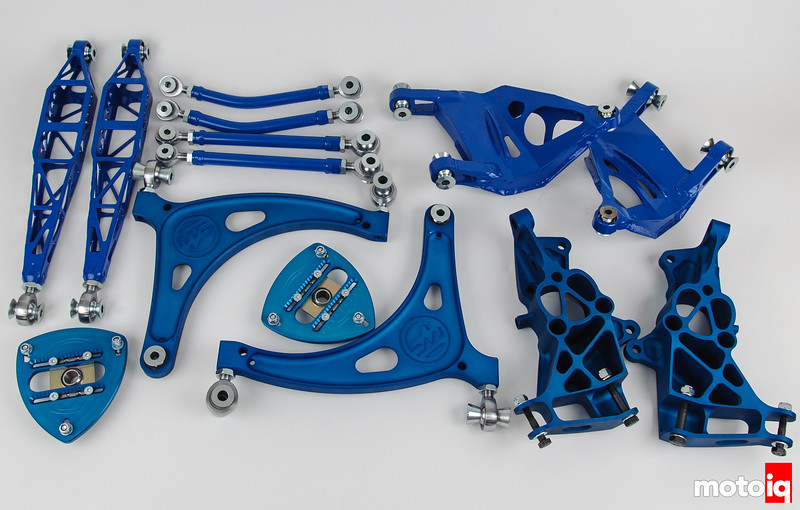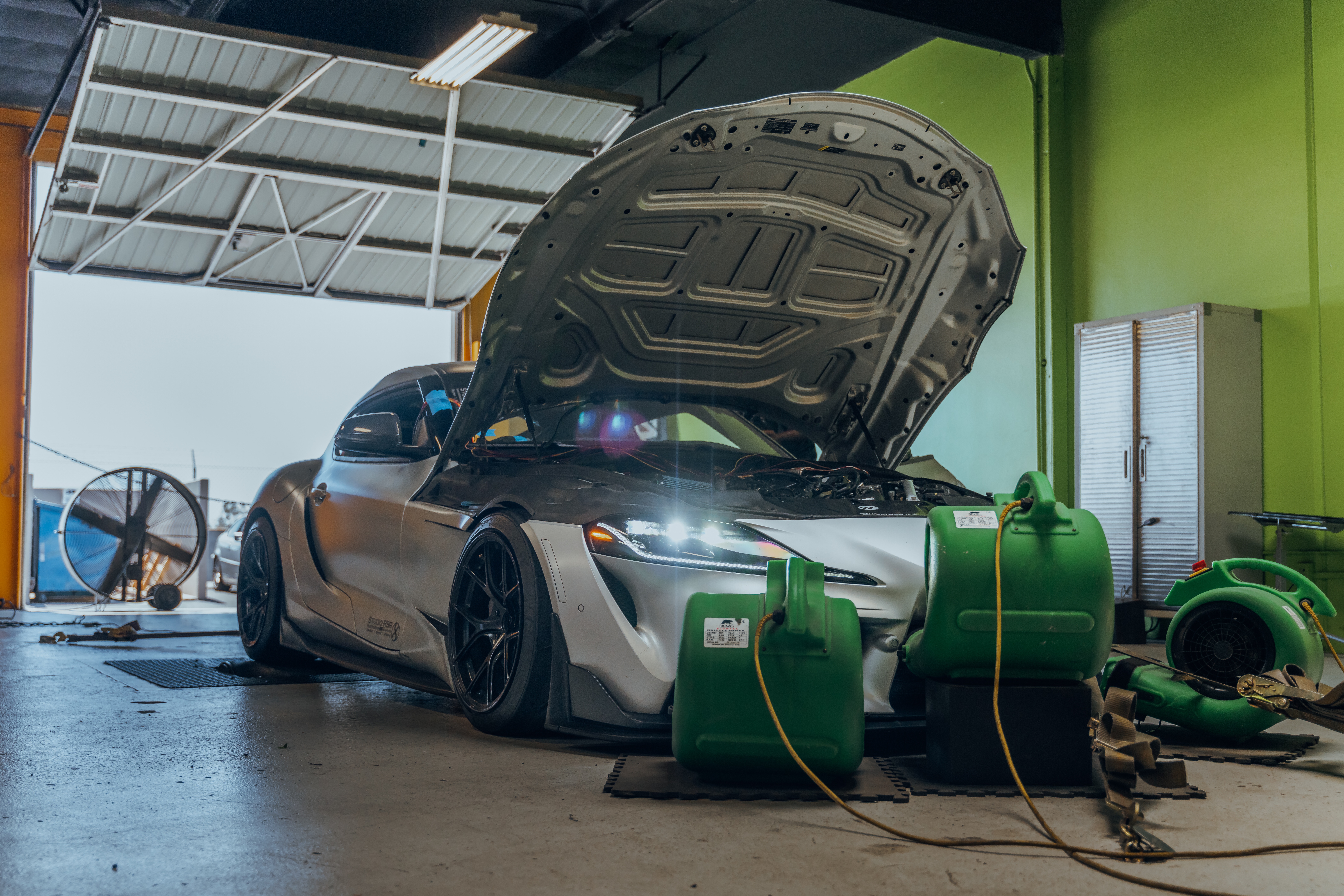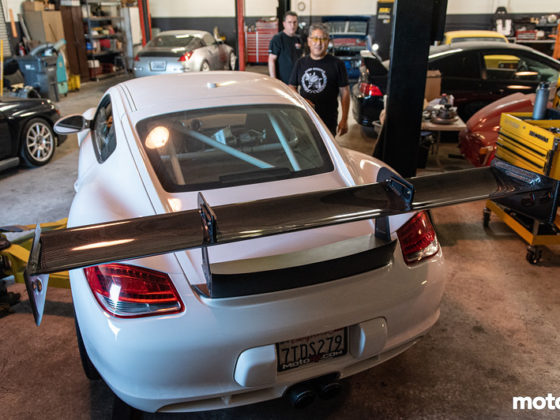
As you can see here the rear Wisefab upright is a lot different than the OEM part. The first part is that you can see that the axle, wheel hubs and brake caliper mounts are moved up to lower the car. Next, you can see that the lower control arm mount and the leading link mount are more in-plane and higher. This reduces toe steer and reduces the amount of anti-squat in the suspension geometry. Anti-squat can reduce the amount of forward and side grip when torque is fed through the suspension and it can also cause wheel hop when accelerating and experiencing wheel spin. Toe steer can cause unpredictable handling as the car’s suspension moves dynamically. The stock FR-S geometry has a lot of toe steer in the back, mostly toe out. We think this was done either to make the car easier to drift with low power or a mistake due to the car’s parts bin engineering of a mash-up of Subaru Impressa parts. The toe steer isn’t so noticeably bad with stock power but with high-powered engines, it can make a wild ride. The Pikes Peak car was nearly undrivable until we corrected it for instance.

On the Wisefab kit, the toe link is mounted much further outboard than the stock link and lined up in more of a clean angle bisecting the angle of the upper and lower control arm. The link is also much longer. These things greatly reduce toe steer. You can see the length difference when you compare the Wisefab part against the stock length Cusco toe link shown here.

You can see how the Wisefab upper arm is much shorter than the stock part. This gives a lot more camber gain in roll. This will allow us to be able to run much less static negative camber which will help our acceleration and braking traction considerably without hurting cornering traction.

The Wisefab arm is a lot less substantial than the Cusco arm shown below. If we were building a big power car with big tires and aero, we would seriously consider adding some gussets to the Wisefab arm like they do in Formula Drift and what we did on the Pikes Peak car.

The Wisefab parts pretty much bolted in place of the stock parts. Unfortunately, we ran into a hiccup. The rear uprights lower the car too much if you are running a shorter than stock shock. We ran out of threads on the shock body and the car was super low. We got longer springs and there was hardly any droop travel.




22 comments
This sounds like a weird consideration but I wonder if that adapter for the front upright is to save costs – it looks like if that was made as part of the same machined upright, the billet would have to be an inch or two “taller” and everything but that one mount would have to get turned into chips.
It seems like the geometry changes the Wisefab kit makes make a lot of sense but I’m with you in feeling weird about the whole idea of going down in rod end sizes, plus the skeletonized arms… I don’t know.
I think they used the same upright as their drift kit possibly.
“We hope that Wisefab might consider some of the issues we have with the kit and make some small improvements to it.”
It looks like the current kit on sale has already improved on some of these issues. The rear lower control arm and the bent toe arm look signficantly beefier.
About the front adapter, perhaps it’s for the guys who want to run massive offset wheels so they can attach the strut to the outer mounting points and have less radial load on the shock absorber shaft.
That’s great that the parts are beefed up! I still don’t see why the adaptor is needed. The strut hits the wheel without it. Why cant the upright just be made with it incorporated into the design? One thing is that Wisefab has great customer service. Our kit was missing a few small parts and they had them in our hands in two days with one email!
I do a bolt on strut mount on the Evo uprights (SSB Designs) for 2 reasons. 1, its a 3″ tall block to machine instead of a 5.5″ tall block. 2, Flexibility in offset, height, and camber. I get requests for a bunch of different flavors like a reduced ride height version for a Mirage Proto in Singapore or my Extremely long version to push the strut to the inner wall for max tire clearance.
Single piece is fine, but there’s very little drawback in separate parts in practice.
I need to talk to you about Evo parts!
It is great that you saw even more improvements in the handling of the car- it really has been a fantastic project car (followed closely by the cayman). It is equally valuable to hear of the challenges with the installation, and the concerns over aspects of durability. Hopefully further design and component refinements are made by WiseFab- the adjustability of this setup really makes it an appealing option for any 86/BRZ that sees regular or dedicated track use.
Regarding the bearings and the decreased self-centering of the steering- is it an issue of the small bearings binding under a load that would be distributed more evenly with a larger bearing? Do you know if they use a bearing with a low friction liner, or grooved liner designed to be used with lubrication?
Disclaimer: I went straight to google after reading this article – the SKF bearing website had a great “principles of selection and application” section, which lead me to ask about the type of bearing, and whether that could be an issue. Prior to that search, my knowledge was limited to “yep, that is a spherical bearing (heim/rose joint)” 😀
I think higher quality bearings would help and when these bearings break in. After one day at the track, it was getting much better so I think another day at the track will do it.
y’all should ditch the front and make your own double wishbone setup like HKS did with their “look what we can do but we’re not gonna sell any of these parts” time attack 86.
IIRC it’s RX8 based?
based on the pics I saw it looked completely custom
https://youtu.be/fqf0Os5xoao?t=420
Looks like custom mounts, uprights and RX8 control arms.
my memory has betrayed me… I was remembering a fab’d A-arm out of small diameter tubes…
It is not RX8 parts, if anything they are similar to VA Impreza parts. The RX8 has upper control arms, this is McPherson strut.
We’re talking about the HKS car which did a double wishbone conversion (well, added an upper arm). see youtube link Rich posted.
Yeah that has nothing to do with this car and it confused me!
well… nothing other than you should do the same 😀
Placing rods so the stud is in bending stress is bad engineering. It’s a common error and just makes me cringe when I see it on suspension parts.
your exactly right
I wish the wisefab kit wasnt so $$$. Do you have any experience or knowledge regarding the quality and design of the Partshop Max kit for the FRS? It looks like it offers similar features as the wisefab.
This article should be named “Hella flush done correctly”
Just a question: why didn’t you keep the 8 degrees of caster you used to run before without wisefab kit?
I have been running less caster with wider wheels and tires as of lately. I have been finding that I don’t like the weight jacking that a lot of caster causes, especially with strut cars.